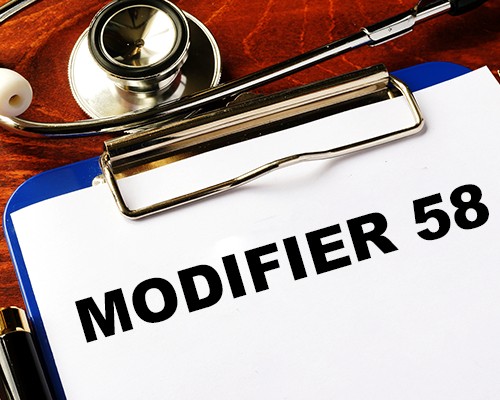Modifiers can be extremely confusing, especially when it comes to deciding which one to use. Selecting the wrong one can lead to payment denials from insurance companies and puts practices at risk for payers requesting refunds. Today’s post will focus on modifier 58.
What is Modifier 58?
Modifier 58 can easily be mixed up with modifiers 78 and 79. However, it’s a staged or related procedure performed by the same physician during the post-operative period following an initial procedure. The two procedures are related to one another. When the staged procedure is billed, the new post-operative period begins.
When to Use Modifier 58
There are 3 reasons to use modifier 58. The first reason is the subsequent procedure was planned. Unplanned secondary procedures typically don’t fall under modifier 58. The second reason is the subsequent procedure was more extensive than the first procedure. This can be either part of the process or because the first didn’t have the desired outcome. The third reason is a need to indicate therapy after a diagnostic surgical procedure.
Examples of When to Use Modifier 58
For the first example, we’ll hang with Josh, who’s visiting his dermatologist. During the visit, his dermatologist finds a malignant patch of skin, which she removes. A few days after the initial procedure, Josh returns to his dermatologist, who closes the wound.
For the second example, we’ll hang with Leslie. Leslie spent too much time at the beach and got a very bad sunburn as a result. She goes to her doctor, who debrides her burn. The first layer is removed, but her doctor knows she will need multiple debridements.
For the third example, we’ll hang with Jane. After noticing a lump in her breast, she visited her doctor, who performed a biopsy. The biopsy comes back and Jane is diagnosed with breast cancer. Upon hearing the news, Jane schedules an appointment for the same surgeon to perform a modified breast mastectomy.
When NOT to Use Modifier 58
Sometimes, it can be easier to remember when not to use a specific modifier. Below are examples of what would not constitute the use of modifier 58:
- A different physician performs the second procedure
- The procedure is unrelated
- The procedure doesn’t take place in the post-operative period
- The procedure wasn’t staged/planned at the time of the first procedure
- In cases of assistant at surgery services
Compared to 24, 59, 78, and 79, modifier 58 can sometimes be confused with modifiers 78 and 79. The key takeaway is there is a second planned, related procedure performed by the same doctor. Procedures that have multiple stages or need to be repeated are most likely to fall under modifier 58.



